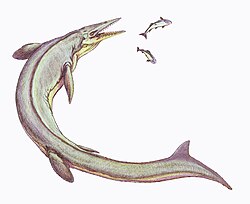Vertebrate paleofauna
Fish
Cartilaginous fish
| Cartilaginous fish of the Demopolis Chalk Formation | ||||
|---|---|---|---|---|
| Genus | Species | Presence | Notes | Images |
Chimaeriformes indet. [4] |    | |||
An otodontid | ||||
S. texanus [4] | ||||
S. serrata? [4] | A lamniform shark | |||
S. kaupi [4] | ||||
S. sp. [4] | ||||
Bony fish
| Bony fish of the Demopolis Chalk Formation | ||||
|---|---|---|---|---|
| Genus | Species | Presence | Notes | Images |
E. ferox [4] |    | |||
E. gladiolus [4] | ||||
E. petrosus [4] | ||||
P. sp. [4] | ||||
S. sp. [4] | ||||
S. sp. [4] | An aulopiform | |||
X. vetus [5] | ||||
Reptiles
Dinosaurs
Indeterminate hadrosaurid remains have been found in Tennessee. [3] Possible indeterminate tyrannosaurid remains have been found in Alabama. [3]
| Dinosaurs of the Demopolis Chalk Formation | ||||
|---|---|---|---|---|
| Genus | Species | Presence | Notes | Images |
 | ||||
Crocodylians
| Crocodylians of the Demopolis Chalk Formation | ||||
|---|---|---|---|---|
| Genus | Species | Presence | Notes | Images |
B. sp. [4] | An eusuchian |  | ||
Mosasaurs
| Mosasaurs of the Demopolis Chalk | ||||
|---|---|---|---|---|
| Genus | Species | Presence | Notes | Images |
C. propython [4] |   | |||
H. sp. [4] | ||||
M. cf. missouriensis [4] | ||||
P. cf. somenensis [4] | Alabama [4] and Mississippi [6] | |||
P. sp. nov. [7] | Mississippi [6] | |||
T. sp. [4] | Alabama [4] and Mississippi [6] | |||
Turtles
| Turtles of the Demopolis Chalk | ||||
|---|---|---|---|---|
| Genus | Species | Presence | Notes | Images |
A. parhami [8] | Geographically present in Alabama and Mississippi. [8] | A marine ctenochelyid turtle |  | |
C. barberi [4] | ||||
C. cf. tennuitesta [4] | ||||
P. matutina? [4] | ||||
P. gigas [4] | ||||